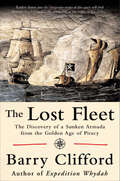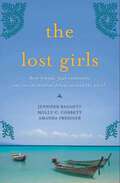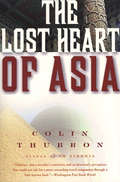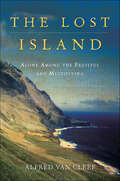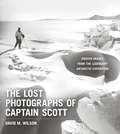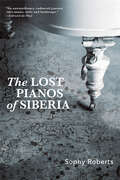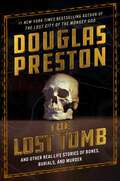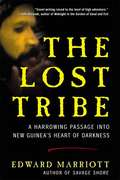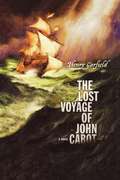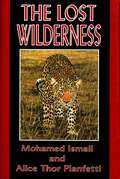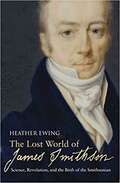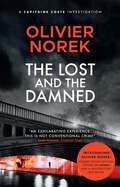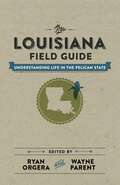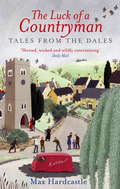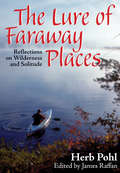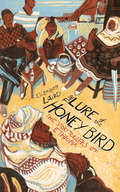- Table View
- List View
The Lost Continent
by Bill BrysonAn unsparing and hilarious account of one man's rediscovery of America and his search for the perfect small town.
The Lost Continent: Travels in Small-Town America
by Bill BrysonFrom the Publisher: An unsparing and hilarious account of one man's rediscovery of America and his search for the perfect small town.
The Lost Explorer
by David Roberts Conrad AnkerThis is the adventure story of the year -- how Conrad Anker found the body of George Mallory on Mount Everest, casting an entirely new light on the mystery of the explorer who may have conquered Everest seventy-five years ago. On June 8, 1924, George Leigh Mallory and Andrew "Sandy" Irvine were last seen climbing toward the summit of Mount Everest. Clouds soon closed around them, and they vanished into history. Ever since, mountaineers have wondered whether they reached the summit twenty-nine years before Edmund Hillary and Tenzing Norgay. On May 1, 1999, Conrad Anker, one of the world's strongest mountaineers, discovered Mallory's body lying facedown, frozen into the scree and naturally mummified at 27,000 feet on Everest's north face. The condition of the body, as well as the artifacts found with Mallory, including goggles, an altimeter, and a carefully wrapped bundle of personal letters, are important clues in determining his fate. Seventeen days later, Anker free-climbed the Second Step, a 90-foot sheer cliff that is the single hardest obstacle on the north ridge. The first expedition known to have conquered the Second Step, a Chinese team in 1975, had tied a ladder to the cliff, leaving unanswered the question of whether Mallory could have climbed it in 1924. Anker's climb was the first test since Mallory's of the cliff's true difficulty. In treacherous conditions, Anker led teammate Dave Hahn from the Second Step to the summit. Reflecting on the climb, Anker explains why he thinks Mallory and Irvine failed to make the summit, but at the same time, he expresses his awe at Mallory's achievement with the primitive equipment of the time. Stunningly handsome and charismatic, Mallory charmed everyone who met him during his lifetime and continues to fascinate mountaineers today. He was an able writer, a favorite of the Bloomsbury circle, and a climber of legendary gracefulness. The Lost Exploreris the remarkable story of this extraordinarily talented man and of the equally talented modern climber who spearheaded a discovery that may ultimately help solve the mystery of Mallory's disappearance.
The Lost Fleet: The Discovery of a Sunken Armada from the Golden Age of Piracy
by Barry CliffordAn explorer recounts historic events surrounding the sinking of a seventeenth-century, eighteen-ship French fleet, along with modern-day efforts to find it. On January 2, 1678, a fleet of French ships sank off the Venezuelan coast. This proved disastrous for French naval power in the region, and sparked the rise of a golden age of piracy. Tracing the lives of fabled pirates like the Chevalier de Grammont, Nikolaas Van Hoorn, Thomas Paine, and Jean Comte d&’Estrées, The Lost Fleet portrays a dark age, when the outcasts of European society formed a democracy of buccaneers, settling on a string of islands off the African coast. From there, the pirates haunted the world&’s oceans, wreaking havoc on the settlements along the Spanish mainland and—often enlisted by French and English governments—sacking ships, ports, and coastal towns. More than three hundred years later, writer, explorer, and deep-sea diver Barry Clifford follows the pirates&’ destructive wake back to Venezuela. With the help of a lost map, drawn by the captain of the lost French fleet, Clifford locates the site of the disaster and wreckage of the once-mighty armada.
The Lost Girls: Three Friends. Four Continents. One Unconventional Detour Around the World.
by Jennifer Baggett Holly C. Corbett Amanda PressnerThree friends, each on the brink of a quarter-life crisis, embark on a year-long backpacking adventure around the world in The Lost Girls.“A triumphant journey about losing yourself, finding yourself and coming home again. Hitch yourself to their ride: you’ll embark on a transformative journey of your own.” —New York Times bestselling author Allison Winn ScotchWith their thirtieth birthdays looming, Jennifer Baggett, Holly C. Corbett, and Amanda Pressner are feeling the pressure to hit certain milestones—score the big promotion, find a soul mate, have 2.2 kids. Instead, they make a pact to quit their high-pressure New York City media jobs and leave behind their friends, boyfriends, and everything familiar to set out on a journey in search of inspiration and direction.Traveling 60,000 miles across four continents, Jen, Holly, and Amanda push themselves far outside their comfort zones to embrace every adventure. Ultimately, theirs is a story of true friendship—a bond forged by sharing beds and backpacks, enduring exotic illnesses, trekking across mountains, and standing by one another through heartaches, whirlwind romances, and everything in the world in between. “A real-life fairy tale for anyone who’s ever wanted to chuck it all and see the world with a best friend on each arm.” —Cathy Alter, author of Up for Renewal“Three cheers to The Lost Girls for showing us, with good humor and graceful prose, the beauty and importance of leading life astray.” —New York Times bestselling author Franz Wisner
The Lost Heart of Asia
by Colin ThubronA land of enormous proportions, countless secrets, and incredible history, Central Asia was the heart of the great Mongol empire of Tamerlane and scene of Stalin's cruelest deportations. A remote and fascinating region in a constant state of transition-never more so than since the collapse of the Soviet Union-it encompasses terrain as diverse as the Kazakh steppes, the Karakum desert, and the Pamir mountains. In The Lost Heart of Asia, acclaimed, bestselling travel writer Colin Thubron carries readers on an extraordinary journey through this little understood, rarely visited, yet increasingly important corner of the world.
The Lost Island: Alone Among the Fruitful and Multiplying
by Alfred van CleefA striking narrative of a man's inadvertent discovery of the life force that persists in the most secluded of places--and isolated of beingsAfter the death of his father, Alfred Van Cleef--the last of a family of Dutch Jews--learns that he is unable to have children. Seeking the remotest spot on the planet, far from the gleefully reproducing couples of Amsterdam, Van Cleef picks a forbidding island in the Indian Ocean, a bizarrely bureaucratic French weather station, two thousand miles from the nearest continent. Finally entrenched on this lonely, wind-battered rock--following an eight-year odyssey to obtain a visiting permit and three weeks' rough passage--Van Cleef anticipates a total escape from the sexual frenzy of humanity: the island, ironically named Amsterdam, is inhabited solely by a group of thirty-six men. Yet this stark environment turns out to house a riotously mating society of albatrosses, sea elephants, fur seals--and especially bdelloid rotifers, an all-female species able to reproduce without males. It is in this unlikely setting that Van Cleef is forced to reckon with his most profound existential concerns.With wry humor and probing insight, Van Cleef weaves geography, natural history, and biology into The Lost Island, an original narrative of a lost island and a man, finally found.
The Lost Photographs Of Captain Scott: Unseen Images From The Legendary Antarctic Expedition
by Dr. David M. WilsonCaptain Scott perished with four of his fellow explorers on their return from the South Pole in March 1912. Almost immediately the myth was founded, based on Scott's diaries, turning him into an icon of courage in the face of impossible circumstances. But during the final months of that journey Scott also took a series of breathtaking photographs: panoramas of the continent, superb depictions of mountains and formations of ice and snow, and photographs of the explorers on the polar trail. But these photos have never been seen - initially fought over, neglected, then lost - until now, that is. For the first time, they are resurrected and are a humbling testament to the men whose graves still lie unmarked in the vastness of the Great Alone.
The Lost Photographs of Captain Scott: Unseen Images from the Legendary Antarctic Expedition
by David M. WilsonThe myth of Scott of the Antarctic, Captain Robert Falcon Scott, icon of fortitude and courage who perished with his fellow explorers on their return from the South Pole on March 29th, 1912, is an enduring one, elevated, dismantled and restored during the turbulence of the succeeding century. Until now, the legend of the doomed Terra Nova expedition has been constructed out of Scott's own diaries and those of his companions, the sketches of 'Uncle Bill' Wilson and the celebrated photographs of Herbert Ponting. Yet for the final, fateful months of their journey, the systematic imaging of this extraordinary scientific endeavor was left to Scott himself, trained by Ponting. In the face of extreme climactic conditions and technical challenges at the dawn of photography, Scott achieved an iconic series of images; breathtaking polar panoramas, geographical and geological formations, and action photographs of the explorers and their animals, remarkable for their technical mastery as well as for their poignancy. Lost, fought over, neglected and finally resurrected, Scott's final photographs are here collected, accurately attributed and catalogued for the first time: a new dimension to the last great expedition of the Heroic Age and a humbling testament to the men whose graves still lie unmarked in the vastness of the Great Alone.
The Lost Pianos of Siberia: A Far-flung Search For Russia's Remarkable Survivors
by Sophy RobertsThis “melodious” mix of music, history, and travelogue “reveals a story inextricably linked to the drama of Russia itself . . . These pages sing like a symphony.” —The Wall Street JournalSiberia’s story is traditionally one of exiles, penal colonies, and unmarked graves. Yet there is another tale to tell. Dotted throughout this remote land are pianos—grand instruments created during the boom years of the nineteenth century, as well as humble Soviet-made uprights that found their way into equally modest homes. They tell the story of how, ever since entering Russian culture under the westernizing influence of Catherine the Great, piano music has run through the country like blood.How these pianos traveled into this snowbound wilderness in the first place is testament to noble acts of fortitude by governors, adventurers, and exiles. Siberian pianos have accomplished extraordinary feats, from the instrument that Maria Volkonsky, wife of an exiled Decembrist revolutionary, used to spread music east of the Urals, to those that brought reprieve to the Soviet Gulag. That these instruments might still exist in such a hostile landscape is remarkable. That they are still capable of making music in far-flung villages is nothing less than a miracle.The Lost Pianos of Siberia follows Roberts on a three-year adventure as she tracks a number of instruments to find one whose history is definitively Siberian. Her journey reveals a desolate land inhabited by wild tigers and deeply shaped by its dark history, yet one that is also profoundly beautiful—and peppered with pianos.“An elegant and nuanced journey through literature, through history, through music, murder and incarceration and revolution, through snow and ice and remoteness, to discover the human face of Siberia. I loved this book.” —Paul Theroux
The Lost Roanoke Colony (History's Mysteries)
by Megan Cooley PetersonIn 1587, a group of about 115 English settlers arrived on Roanoke Island near North Carolina. They were there to establish an English colony. Later that year, the colony’s leader left the island to get supplies. His return trip was delayed. When he finally returned in 1590, the colony and its settlers were gone. What happened to the settlers? Explore the theories behind their disappearance and why it has become one of history’s greatest mysteries.
The Lost Tomb: And Other Real-Life Stories of Bones, Burials, and Murder
by Douglas PrestonFrom the #1 bestselling author of The Lost City of the Monkey God, a jaw-dropping discovery of an Egyptian tomb opens up a slew of archaeological mysteries and deadly tales. Now in paperback with an EXCITING BONUS ADVENTURE! What&’s it like to be the first to enter an Egyptian burial chamber that&’s been sealed for thousands of years? What horrifying secret was found among the prehistoric ruins of the American Southwest? Who really was the infamous the Monster of Florence? From the jungles of Honduras to macabre archaeological sites in the American Southwest, Douglas Preston's explorations have taken him across the globe. The Lost Tomb brings together a compelling collection of true stories about buried treasure, enigmatic murders, lost tombs, bizarre crimes, and other fascinating tales of the past and present.
The Lost Tribe
by Edward MarriottTwo years before this story begins, the Liawep were living deep in the jungle of Papua, New Guinea, long forgotten by the outside world. Numbering seventy-nine men, women, and children, the tribe worshipped a mountain, dressed in leaves, and hid when planes flew overhead, believing them to be evil sanguma birds. Their discovery by a missionary hit the headlines in 1993. Galvanized by the reports of people living in Stone Age conditions, Edward Marriott set out to find the Liawep. Banned from visiting the tribe by the New Guinea government, he assembled his own ragtag patrol and ventured illegally into the wilderness in search of his quarry. Nothing could have prepared him for what he found or for the dramatic events that followed. A thrilling, superbly written adventure, The Lost Tribe is a memorable account of what happens when good intentions go awry, when rational man meets primal beliefs, and when a small, primitive people are ensnared by the predations of civilization.
The Lost Voyage of John Cabot
by Henry Garfield1498. Sebastian Cabot age fifteen, can only wait and wonder. His famous father has abandoned him at home in Bristol, England, but has taken the boy's older and younger brothers, Ludovico and Sancio, on his second voyage in search of the Asian mainland. On his first journey, sailing north across the Western Ocean in 1497, John Cabot had discovered the New Found Land. He returned to England a hero. Five years earlier, Spain had given Christopher Columbus a similar welcome. He had found Asia, he claimed. And by a southern route. Cabot was skeptical and set out to the north again to prove his old friend a fraud. But silence followed. Now, Sebastian and history are confronted with a tantalizing mystery. What has become of Cabot's second endeavor? Letters to the boy from fourteen-year-old Sancio tell of a fearsome storm and its aftermath. They, and the surprising climax to Sebastian's and Sancio's shared story, make for unforgettable voyaging.
The Lost Wilderness: Tales of East Africa
by Mohamed IsmailThis is the story of Mohemed Ismail's years in Kenya and Tanzania as a game warden and professional hunter. In this book Ismail chronicles the life experiences of five native Africans who worked with him during his years as a game warden as well as his own experiences as a professional hunter.
The Lost World of James Smithson: Science, Revolution, and the Birth of the Smithsonian
by Heather EwingIn 1836 the United States government received a strange and unprecedented gift―a half-million dollar bequest to establish a foundation in Washington "for the increase and diffusion of knowledge among men." The Smithsonian Institution, as it would be called, eventually grew into the largest museum and research complex in the world. Yet the man behind what became "America's attic," James Smithson, has remained a shadowy figure for more than 150 years. <p><p> Drawing on unpublished diaries and letters from across Europe and the United States, historian Heather Ewing tells his compelling story in full. The illegitimate son of the Duke of Northumberland, Smithson was the youngest member of Britain's Royal Society and a talented chemist admired by the greatest scientists of his age. At the same time, however, he was also a suspected spy, an inveterate gambler, and a radical revolutionary during the turbulent years of the Napoleonic Wars. But at the heart of Smithson's story is his bequest―worth $9 million in today in today's currency―which sparked an international lawsuit and a decade-long congressional battle, featuring a dizzying cast of historical figures, including John Quincy Adams, and Alexander Graham Bell, both of whom grappled with how―and even whether―to put Smithson's endowment to use. <p><p> Fascinating and magisterial, Ewing's biography presents a sweeping portrait of a remarkable man at the center of the English Enlightenment and the creation of America's greatest museum.
The Lost and the Damned: Sunday Times Crime Book of the Month (Banlieues Trilogy, The)
by Olivier NorekThis impressive debut is slick, sick and not for the faint-hearted. The first 30 pages contain what must be one of the most shocking scenes ever committed to paper. It will make you cry out (for more) - Mark Sanderson, The Times Crime Book of the MonthIntroducing Olivier Norek: Former police officer, writer on Spiral and an award-winning, million-copy bestseller.A corpse that wakes up during the autopsy. A case of spontaneous human combustion. There is little by the way of violent crime that Capitaine Victor Coste has not encountered in his fifteen years policing France's most notorious suburb - but nothing like this. As he struggles to find a link between the cases, he receives a pair of anonymous letters highlighting the fates of two women whose deaths were never explained - two more blurred faces among the ranks of the lost and the damned.Why were their murders not investigated? Coste is not the only one asking that question. Someone out there believes justice is best served on a cold mortuary slab. What readers are saying about The Lost and the DamnedYou can see the similarities with the TV series Spiral, which can only be a major positive!A hard hitting and gritty French crime read that makes an impact.A great thriller, sardonic, humorous, dark.I loved this book. Well written and had an authentic feel to it. A complete page turner.Translated from the French by Nick Caistor
The Louisiana Field Guide: Understanding Life in the Pelican State
by Anthony Lewis Karen Williams Michael Pasquier Alecia P. Long Alex V. Cook Barry Cowan Wayne Parent Kent Mathewson Thomas Klingler Ryan Orgera J. Michael Desmond David Harlan Raynie Harlan Joyce Jackson Aaron Emmitte Sylvie DuBois Zachary GodshallIn Louisiana, every bite of food and each turn of phrase is an expression of cultural literacy. Correctly pronouncing "Tchoupitoulas" or "Atchafalaya," knowing the difference between the first Governor Long and the second one, being able to spot the artwork of Caroline Durieux, and honoring the distinction between a Creole and a Cajun roux serve not just as markers of familiarity; they represent acts of preservation. The Louisiana Field Guide: Understanding Life in the Pelican State expands on this everyday communion of history, delving into the cultural patchwork that makes the Gumbo State both thoroughly American and absolutely singular.An authoritative lineup of contributors reintroduces Louisiana through the lenses of environment, geography, history, politics, religion, culture, language, sports, literature, film, music, architecture, food, and art. Whether describing the archi-tectural details of the Ursuline Convent in the French Quarter or sharing the family history of Bourgeois' Meat Market just outside of Thibodaux, the essays in The Louisiana Field Guide present a fresh and expansive look at the enchanting and perplexing Pelican State.At once an accessible primer and a rich omnibus, this volume explores the well-known destinations and far-flung corners of Louisiana, from Cameron Parish to Congo Square, offering an enlightening companion guide for visitors and a trust-worthy reference for residents.
The Love of Strangers
by Nile GreenIn July 1815, six Iranian students arrived in London under the escort of their chaperone, Captain Joseph D'Arcy. Their mission was to master the modern sciences behind the rapid rise of Europe. Over the next four years, they lived both the low life and high life of Regency London, from being down and out after their abandonment by D'Arcy to charming their way into society and landing on the gossip pages. The Love of Strangers tells the story of their search for love and learning in Jane Austen's England.Drawing on the Persian diary of the student Mirza Salih and the letters of his companions, Nile Green vividly describes how these adaptable Muslim migrants learned to enjoy the opera and take the waters at Bath. But there was more than frivolity to their student years in London. Burdened with acquiring the technology to defend Iran against Russia, they talked their way into the observatories, hospitals, and steam-powered factories that placed England at the forefront of the scientific revolution. All the while, Salih dreamed of becoming the first Muslim to study at Oxford.The Love of Strangers chronicles the frustration and fellowship of six young men abroad to open a unique window onto the transformative encounter between an Evangelical England and an Islamic Iran at the dawn of the modern age. This is that rarest of books about the Middle East and the West: a story of friendships.
The Luck Of A Countryman: Tales from the Dales
by Max HardcastleA vivid and charming portrait of life in the Yorkshire DalesThe enchanting sequel to A Countryman's Lot, which told the story of Max Hardcastle's move to the Yorkshire Dales and the richness of life as an antiques dealer, The Luck of a Countryman contains an array of eccentric characters and curious situations which are guaranteed to delight and amuse. Old favourites reappear in new -- and sometimes alarming -- situations. And a myriad of new personalities join in the ups and downs of life in the Dales.Life is not all plain sailing, but the Hardcastles join in wholeheartedly with the trials and triumphs that beset the peaceful village of Ramsthwaite. How will they ever shift Thievin' Jack's van from the pond? And will the wedding of the year go off smoothly?
The Luck Of A Countryman: Tales from the Dales
by Max HardcastleA vivid and charming portrait of life in the Yorkshire DalesThe enchanting sequel to A Countryman's Lot, which told the story of Max Hardcastle's move to the Yorkshire Dales and the richness of life as an antiques dealer, The Luck of a Countryman contains an array of eccentric characters and curious situations which are guaranteed to delight and amuse. Old favourites reappear in new -- and sometimes alarming -- situations. And a myriad of new personalities join in the ups and downs of life in the Dales.Life is not all plain sailing, but the Hardcastles join in wholeheartedly with the trials and triumphs that beset the peaceful village of Ramsthwaite. How will they ever shift Thievin' Jack's van from the pond? And will the wedding of the year go off smoothly?
The Lunatic Express: Discovering the World … via Its Most Dangerous Buses, Boats, Trains, and Planes
by Carl HoffmanIndonesian Ferry Sinks. Peruvian Bus Plunges Off Cliff. African Train Attacked by Mobs. Whenever he picked up the newspaper, Carl Hoffman noticed those short news bulletins, which seemed about as far from the idea of tourism, travel as the pursuit of pleasure, as it was possible to get. So off he went, spending six months circumnavigating the globe on the world's worst conveyances: the statistically most dangerous airlines, the most crowded and dangerous ferries, the slowest buses, and the most rickety trains. The Lunatic Express takes us into the heart of the world, to some its most teeming cities and remotest places: from Havana to Bogotá on the perilous Cuban Airways. Lima to the Amazon on crowded night buses where the road is a washed-out track. Across Indonesia and Bangladesh by overcrowded ferries that kill 1,000 passengers a year. On commuter trains in Mumbai so crowded that dozens perish daily, across Afghanistan as the Taliban closes in, and, scariest of all, Los Angeles to Washington, D. C. , by Greyhound. The Lunatic Express is the story of traveling with seatmates and deck mates who have left home without American Express cards on conveyances that don't take Visa, and seldom take you anywhere you'd want to go. But it's also the story of traveling as it used to be -- a sometimes harrowing trial, of finding adventure in a modern, rapidly urbanizing world and the generosity of poor strangers, from ear cleaners to urban bus drivers to itinerant roughnecks, who make up most of the world's population. More than just an adventure story, The Lunatic Express is a funny, harrowing and insightful look at the world as it is, a planet full of hundreds of millions of people, mostly poor, on the move and seeking their fortunes.
The Lure of Faraway Places
by James Raffan Herb PohlThe Lure of Faraway Places is the publication canoeist Herb Pohl (1930-2006) did not live to see published. But Pohl's words and images provide a unique portrait of Canada by one who was happiest when travelling our northern waterways alone. Austrian-born Herb Pohl died at the mouth of the Michipcoten River on July 17, 2006. He is remembered as "Canada's most remarkable solo traveller." While mourning their loss, Herb Pohl's friends found, to their surprise and delight, a manuscript of wilderness writings on his desk in his lakeside apartment in Burlington, Ontario. He had hoped one day to publish his work as a book. With help and commentary from best-selling canoe author and editor James Raffan, Natural Heritage is proud to present that book, Herb's book, The Lure of Faraway Places. "There's nothing like it in canoeing literature," says Raffan. "It's part journal, part memoir, part wilderness philosophy and part tips and tricks of the most pragmatic kind written about parts of the country most of us will never see by the most committed and ambitious solo canoeist in Canadian history."
The Lure of the Beach: A Global History
by Robert C. RitchieA human and global take on a beloved vacation spot. The crash of surf, smell of salted air, wet whorls of sand underfoot. These are the sensations of the beach, that environment that has drawn humans to its life-sustaining shores for millennia. And while the gull’s cry and the cove’s splendor have remained constant throughout time, our relationship with the beach has been as fluid as the runnels left behind by the tide’s turning.The Lure of the Beach is a chronicle of humanity's history with the coast, taking us from the seaside pleasure palaces of Roman elites and the aquatic rituals of medieval pilgrims, to the venues of modern resort towns and beyond. Robert C. Ritchie traces the contours of the material and social economies of the beach throughout time, covering changes in the social status of beach goers, the technology of transport, and the development of fashion (from nudity to Victorianism and back again), as well as the geographic spread of modern beach-going from England to France, across the Mediterranean, and from nineteenth-century America to the world. And as climate change and rising sea levels erode the familiar faces of our coasts, we are poised for a contemporary reckoning with our relationship—and responsibilities—to our beaches and their ecosystems. The Lure of the Beach demonstrates that whether as a commodified pastoral destination, a site of ecological resplendency, or a flashpoint between private ownership and public access, the history of the beach is a human one that deserves to be told now more than ever before.
The Lure of the Honey Bird: The Storytellers of Ethiopia
by Elizabeth LairdThe acclaimed author travels across Ethiopia collecting folktales in this travelogue featuring many of the fabulous stories she heard. In 1967, at the age of 23, Elizabeth Laird set off for Addis Ababa, Ethiopia&’s capital city, to start her first teaching job. She was introduced to Emperor Haile Selassie, made a pilgrimage across the mountains on foot to the ancient city of Lalibela, hitched a ride on an oil tanker across the Danakil Desert, and was arrested—briefly—for a murder she did not commit. Back in Britain, Laird established herself as a major author of fiction for children and young adults, but she always wanted to return to Ethiopia. Her chance came in the late 1990s, when the British Council in Addis Ababa invited her to collect folk stories from every region of the country. Encountering ex-guerrilla fighters, camel traders, Coptic nuns and tribespeople en route, Laird has written a remarkable account of her journey interwoven with a treasure trove of stories featuring princes and maidens, snakes and lions, zombies and hyena-women.



